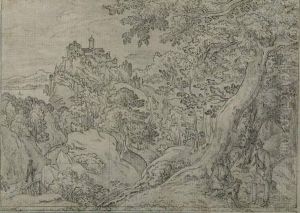Johann Jakob Kirchner Paintings
Johann Jakob Kirchner was a German sculptor born in the late 17th century, specifically around 1689/90. His life and work are less documented than many of his contemporaries, and as a result, details about his early life and training are relatively sparse. What is known is that he became active as a sculptor and worked primarily in the Baroque style, which was prevalent in Europe during his lifetime.
Kirchner's work was part of the Baroque cultural movement, which was characterized by dramatic expression, grandeur, and a dynamic movement in art. This style was particularly suited to the Catholic Church's Counter-Reformation goals, aiming to inspire and awe the faithful. Kirchner, like many artists of his time, would have been influenced by the works of Gian Lorenzo Bernini and other Italian masters.
He is known to have spent some of his career in Dresden, where he contributed to the decoration of the city's buildings and sculptures. Dresden was a significant cultural center in the early 18th century, and Kirchner would have been part of a vibrant artistic community there. The city was the capital of Saxony and was undergoing extensive architectural and artistic development under the rule of Augustus the Strong.
Kirchner's death is recorded as having occurred in 1743. Unfortunately, much of his work, like that of many artists of the period, may not have survived or has been attributed to him with uncertainty due to the lack of strong historical records. Nonetheless, he remains a figure of interest for those studying the Baroque period and German sculpture, contributing to the rich tapestry of 18th-century European art.
Due to the limited information available about Johann Jakob Kirchner, a more detailed biography may not be possible without further historical discoveries or scholarly research that could shed light on his life and oeuvre. Until then, his work is appreciated within the context of the broader movements of his time and the cultural developments of the regions in which he was active.


